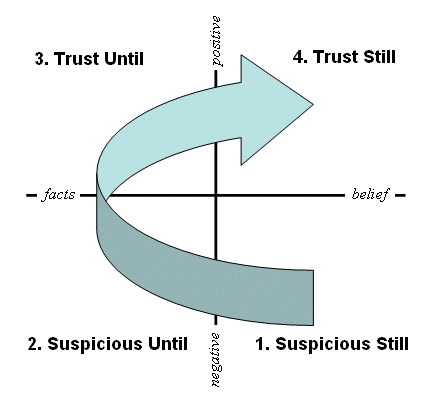A Theory of Trust in Healthcare

A Concept of Trust as a Theory
Concepts have been identified as observed phenomenon and said to be the building blocks of theory (Bell & Duffy, 2009). Chinn and Kramer (2011) believe that concepts do not remain static but instead change over time and in different contexts and should justifiably relate to the practice of nursing (p. 163). According to Bell and Duffy (2009), people moving towards distrust when expectations were not being met changed course as a result of trusting interactions, thus describing trust as dynamic and complex.
Trust can be defined in various ways depending on literature and dictionary use. The Oxford Dictionary Online (2011) defines trust as, “Confidence in or reliance on some quality or attribute of a person or thing, or the truth of a statement.” Bell and Duffy (2009) state trust is “the optimistic acceptance of a vulnerable situation, following careful assessment, in which the truster believes that the trustee has his best interests as paramount.” Furthermore, Radwin and Cabral (2010) define trust theoretically as “the confidence that care would be appropriate, reliable and as successful as possible”. I define trust as having confidence in someone or something.
Why is Trust Important to Nursing?
Chinn and Kramer (2011) say that our beliefs and attitudes about the nature of nursing influence our concept choice (p. 163). I believe that the importance of trust in nursing is two-fold. First, trust is an integral part of the nurse-patient relationship. In all patient settings, patients trust their nurses to perform critical surveillance, and to provide comfort, education, and support (Radwin & Cabral, 2010). Without trust in nursing, patients may delay treatment, withhold important information, and have increased anxiety, depression, and pain. They will be less satisfied with the nurses, institutions, and quality of care received.
Trust is also important between nursing staff in order to provide safe, effective, high quality patient care. Nurses rely on each other for assistance with cares, resources for information, and support in times of distress. Without trust, teamwork is a difficult task. Promoting trust can further profits, in that teamwork and communication are improved, thus increasing productivity (Bell & Duffy, 2009). Student nurses also trust in their nurse educators to teach them correct and complete material. If we promote trust in nursing care, it creates a culture of trust and organizational effectiveness (Bell & Duffy, 2009).

Defining Trust: What Does the Literature Say?
Literature had identified several components of trust. Bell and Duffy (2009) identified the characteristics as expectation of competence, goodwill of others, fragility/vulnerability, and the element of risk. With nursing, the public expects competent performance. “ Once trust in the goodwill of others is established, the truster hands over an element of control to the trusted, hence leading to vulnerability or fragility to either psychological or physical harm” (Bell & Duffy, 2009). The authors go further to describe the element of risk, stating that there is always the possibility that the trustee may not act appropriately (Bell & Duffy, 2009).
Other sources of literature have described trust using overlapping characteristics. Radwin and Cabral’s (2010) characteristics specifically involve patient-centered care. The authors stated attentiveness, caring, coordination, continuity, and competence in the form of professional knowledge characterize trust (Radwin & Cabral, 2010). Thom, Hall, and Pawlson (2004) conceptualized that interpersonal relationship skills, clinician competency, and duty to the patient are the characteristics of trust. All sources agree that clinical competence is an important component.
Assumptions of a Trust Theory
Assumptions
|
|---|
a) A need is required for trust. “The truster must have a perception of competence regarding the trustee; otherwise what they are feeling is hope, rather than trust”
|
b) A past positive outcome with the person or institution must be present for trust to arise.
|
c) Trust cannot occur unless the risk is evaluated.
|
Bell and Duffy (2009)
Trust and Other Concepts
Structure is essential to theory because it flows from relationships (Chinn & Kramer, 2011, p. 194). We have established that other concepts related to trust include competence, confidence, caring, goodwill, risk, and hope. How does trust and the other concepts relate to nursing research, practice, education, and management?
Trust is a complex concept in that its nature is pervasive and essential (Bell & Duffy, 2009). There are many opportunities to study the association of trust and nursing, particularly between trust, hope, and patient safety. With nursing practice, trust is essential to prevent feelings of betrayal, stress, and vulnerability with patients. Bell and Duffy (2009) state with trust a successful care-giving relationship is formed, reducing anxiety and promoting healing. In terms of education, nurse educators need to embrace trust as it is achieved using skilled interventions, education, and obedience to professional behavior codes (Bell & Duffy, 2009). Mangers who promote an environment of trust will see better productivity through increased teamwork and communication (Bell & Duffy, 2009).
References
Bell, L., & Duffy, A. (2009). A concept analysis of nurse--patient trust. British Journal of Nursing (BJN), 18(1), 46-51. Retrieved from EBSCOhost.
Chinn, P. & Kramer, M. (2011). Integrated theory and knowledge development in nursing (8th Ed.) Mosby Elsevier: St Louis, Missouri
Radwin, L. E., & Cabral, H. J. (2010). Trust in Nurses Scale: construct validity and internal reliability evaluation. Journal of Advanced Nursing, 66(3), 683-689. doi:10.1111/j.1365-2648.2009.05168.x
Ricchiuto, J. (2006). The trust equation [photo]. Retrieved from http://www.networkweaving.com/blog/uploaded_images/TrustEquation-718721.jpg
Thom, D., Hall, M., & Pawlson, L. (2004). Measuring patients' trust in physicians when assessing quality of care: every reason for measuring other aspects of quality applies with equal force to measuring trust. Health Affairs, 23(4), 124-132. Retrieved from EBSCOhost.
Trust, n. (2011). In Oxford English dictionary online. Retrieved from http://www.oed.com.libweb.ben.edu/view/Entry/207004?rskey=MnWPaI&result=1&isAdvanced=false
Yatzeck, E. (2011). Trust builds relationships [photo]. Retrieved from http://pagilista.blogspot.com/2011/02/on-trust.html








